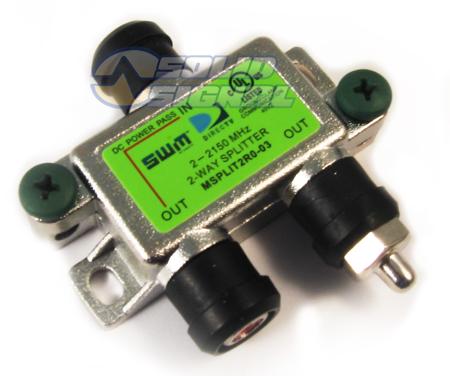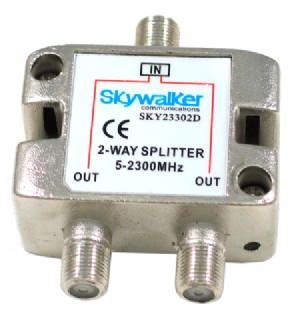They all look the same, right? The splitters at the top of this article look like any other splitter. Yet, there are big differences. Can you spot them? Let’s take a look at three splitters you might see and their uses and misuses.
Splitter #1: Don’t try this at home.

This is a splitter from a home store. It sells for just a few dollars. If you needed a splitter you might be tempted to drive over there, get this one, and put it in place in your satellite system.
Big mistake. Huge.
This splitter might work for a minute or two, but it’s a pretty good bet it won’t even last that long. Why? Because it doesn’t pass all the signals that you need. It says right on the front that it passes signals from 5-900 MHz. This is fine for an antenna but satellite signals go all the way up to 2150 MHz. So, this splitter won’t pass most of the important signals to your receivers. Also, DIRECTV uses the 2.3MHz channel to control their multiswitches, and this splitter doesn’t pass that either. So it would not work at all in a DIRECTV SWM system.
Splitter #2: Green means go.

This is the DIRECTV-approved 2-way splitter for SWM systems. It’s the right choice for wiring inside your home. It doesn’t matter if you have an external multiswitch or if it’s built right into your home. If you are using the DIRECTV SWM system, the green label tells you that it’s the right splitter to use. This splitter is weather resistant when used with the attached rubber boots, and passes the entire signal from 2-2150 MHz. There is also a power-passing leg, meaning that the SWM power inserter can be attached to the red-centered port to power your entire system. Without this feature you could not run your multiswitch.
Splitter #3: Only serious inquiries, please.

This is the Skywalker 23302D splitter. Most homes won’t have a need for this, but if you’re planning on using more than one multiswitch, and especially if you’re not using a SWM system, this is your splitter of choice. It passes all the signals coming from the dish, from 5-2300 MHz. It also passes power on both legs. This splitter is used for sending signals to two multiswitches, and it is designed to pass power from each one. Why? If you’re using older WB68 multiswitches, you must use a dual power-passing splitter or one multiswitch won’t work.
If you’re using a SWM system, using a dual power-passing splitter has two advantages. First of all, theoretically the 22 kHz tones carried on some signals could be out of phase and cancel each other out.. Second, it means that the failure of one multiswitch won’t take down your entire system, because the dish can pull power from either multiswitch.
However, you can’t use this splitter inside the home with a SWM system because it isn’t rated to pass the 2.3MHz control signal, and it isn’t designed for whole home viewing, with a potential 15dB more loss in the coax networking is used.
What happens if you use the wrong splitter?
Using the home-store splitter probably won’t work at all, because it won’t pass enough of the satellite signal.
Using the green-label splitter between the multiswitch and dish could work in a pinch. Over the long term it could cause problems, and it is more expensive than using the correct splitter.
Using the Skywalker splitter between the multiswitch and the receivers probably won’t work at all because it won’t pass the right signals.
Trick question:When is a splitter not a splitter? It’s easy to confuse a diplexer (seen at the top left of this article) with a splitter. If you’re confused about the difference between a splitter, diplexer, and combiner, read our article here.
Also remember, you must be using a SWM system to use splitters inside the home in a DIRECTV system. Splitters won’t work with a non-SWM “legacy” system.





